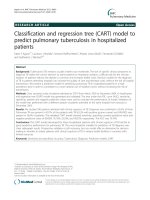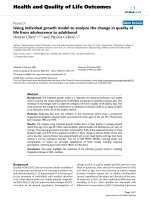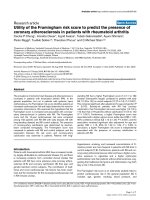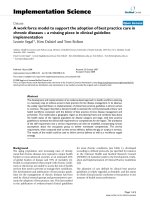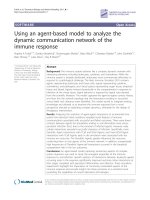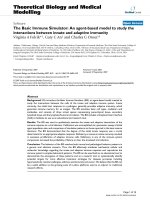Recommended model to predict the regional GDP per capita growth rate Prediction for GDP per capita growth rate in 2021, 2022 and 2023
Bạn đang xem bản rút gọn của tài liệu. Xem và tải ngay bản đầy đủ của tài liệu tại đây (4.15 MB, 46 trang )
ECON1193B – Semester A, 2021
Student Distribution
FIRST
STUDENT
PART
CONTRIBUTION
NAM
ID
DISTRIBUTION
%
E
MAI
S3878898
Part 1, 3, 4
(Conclusion for Part
3), Part 2 (Box and
Whisker), Video
Powerpoint
TAM
S3877398
Part 5,6,7.2 (Region
B), Video Script
100%
ANH
S3880774
Part 5,6,7.2 (Region
A), Video Script
100%
DUNG
S3877053
Part 2 (Median), Part 4
(Conclusion for Part
2), Part 7.1 & 7.3,
Video Presenter
100%
HUY
S3877033
Part 2 (IQR), Part 4
(Conclusion for Part
2), Part 7.1 & 7.3
100%
100%
SIGNATURE
2
ECON1193B – Semester A, 2021
Table of Contents
I. DATA COLLECTION...............................................................................................................4
II. DESCRIPTIVE STATISTICS.................................................................................................4
2.1 Central Tendency.................................................................................................................4
2.2 Variation................................................................................................................................5
2.3 Box-and-Whisker plot..........................................................................................................6
III. MULTIPLE REGRESSION..................................................................................................6
3.1 America.................................................................................................................................6
3.2 Africa...................................................................................................................................10
IV. REGRESSION CONCLUSION...........................................................................................11
V. TIME SERIES.........................................................................................................................12
5.1 Significant trend model......................................................................................................12
5.2 Recommended model to predict the regional GDP per capita growth rate..................18
5.3 Prediction for GDP per capita growth rate in 2021, 2022 and 2023..............................19
VI. TIME SERIES CONCLUSION...........................................................................................20
6.1 Line chart............................................................................................................................20
6.2 Recommended model to predict the world GDP per capita growth rate......................21
VII. OVERALL CONCLUSION................................................................................................21
6.1 Other factors that affect GDP per capita growth rate....................................................21
6.2 The predicted world GDP per capita growth rate in 2030.............................................21
6.3 Recommendations..............................................................................................................22
VIII. REFERENCES...................................................................................................................23
IX. APPENDIX............................................................................................................................24
3
ECON1193B – Semester A, 2021
I.
Data Collection
Our assigned regions are America (Region A) and Africa (Region B), and our assigned year is
2015. The report includes 9 variables. Data of 9 variables is collected from The World Bank. We
collect 45 countries in America and 52 countries in Africa. However, because of some missing
values of some variables, we have to eliminate some countries. Consequently, the final number
of countries included in this report are 27 and 49 countries in America and Africa, respectively.
II.
Descriptive Statistics:
1. Measurement of Central Tendency
To check the outliers, Q1, Q3 and IQR are calculated:
There is one upper outlier (5.76% > Q3+1.5*IQR) and one lower outliers (-4.351% < Q11.5*IQR) in America. In Africa, there are five lower outliers (-5.609%, -6.884%, -9.661%,
-12.131% and -22.312% < Q1-1.5*IQR).
Due to the evidence of outliers in both datasets of America and Africa GDP per capita growth
rate, the mean cannot be used to compare in this situation because of its sensitivity to outliers.
4
ECON1193B – Semester A, 2021
Moreover, the mode might not exist in the datasets, which is correct to the GDP per capita
growth in America and Africa, there is no appearance of mode. Therefore, the median is the most
appropriate measure to analyze owing to its resistance to outliers.
The median of GDP per capita growth rate in America is 1.963%, meaning 50% of observations
(countries) have a growth rate higher than this number. Similarly, 50% of observations
(countries) in Africa have the GDP per capita growth rate higher than 0.974%. Additionally, the
median of America is higher than Africa, showing that GDP per capita growth rate in 2015 of
America is higher than that figure of Africa.
2. Measurement of Variation
In general, all the figures of Africa are excessively higher than that of America. Due to the
sensitivity to outliers, sample variance, standard deviation, coefficients of variation, standard
deviation, and range are not applicable. IQR is not susceptible to outliers, hence, it is the most
suitable measure to compare these GDP per capita growth rates in both regions.
The IQR of GDP per capita growth rate in Africa (3.445%) is larger than the IQR in America
(2.08%), which is about 1.656 times greater. This figure shows that the GDP per capita growth
rate in Africa is more fluctuated than that in America.
5
ECON1193B – Semester A, 2021
3. Box-and-Whisker Plot
Both GDP per capita growth rates in America and Africa had right-skewed shape (mean >
median). There are 5 lower outliers in Africa, and the lowest number is even -22.312%,
indicating that there are many countries with extremely low GDP per capita growth rates.
Meanwhile, the lowest number in America is only -4.351%. Additionally, the left-whisker of
Africa (-3.186% to -0.345%) is located in the lower position than the left-whisker of America (1.507% to 0.53%). Therefore, it can be concluded that the GDP per capita growth rate in Africa
is extremely lower than that in America.
III.
Multiple Regression:
1. America
6
ECON1193B – Semester A, 2021
P-value of Exports of goods and services (% of GDP) and Imports of goods and services (% of
GDP) have #NUM! error. This problem occurs because the independent column is linearly
dependent on the others (multicollinearity).
7
ECON1193B – Semester A, 2021
Therefore, we need to exclude either exports of goods and services or imports of goods and
services.
After applying backward elimination (Appendix A):
Final regression output when eliminating Exports of goods and services:
Final regression output when eliminating Imports of goods and services:
8
ECON1193B – Semester A, 2021
Both p-value of imports of goods and services and trade are lower than 0.05. However, in
comparison, R-square of Imports of goods and services (19.46%) is lower than R-square of Trade
(20.224%). Additionally, P-value of Imports of goods and services (0.021) is higher than P-value
of Trade (0.019). Therefore, Trade is considered as the most significant independent variable.
Regression equation:
shows that when Trade = 0%, the predicted GDP per capita growth rate of GDP per capita is –
0.3%. Nevertheless, this does not make sense because X=0% is out of the observation range.
Slope indicates that GDP per capita will increase 0.029% for every 1% increase in Trade.
Positive value of indicates that the linear relationship between Trade and GDP per capita growth
rate is the positive relationship.
R-square = 20.224% indicates that 20.224% of variation of GDP per capita growth rate can be
explained by variation of Trade.
9
ECON1193B – Semester A, 2021
2. Africa
P-value of Imports of goods and services (% of GDP) and Trade (% of GDP) have #NUM! error.
This problem occurs because the independent column is linearly dependent on the others
(multicollinearity).
10
ECON1193B – Semester A, 2021
Therefore, we need to exclude either trade or imports of goods and services.
After eliminating either Imports of goods and service or Trade, Excel shows the same final
output:
After applying the backward elimination method (Appendix A), the final regression result
indicates no linear relationship between GDP per capita growth rate and 8 independent variables.
P-value of Life expectancy at birth (0.24) is still higher than 0.05, therefore, it is not the
significant independent variable.
IV.
Regression Conclusion
America and Africa have different significant independent variables. While the GDP per capita
growth rate of America is affected by only one independent variable (Trade (% of GDP)),
Africa's GDP per capita growth rate is not affected by any independent variables.
GDP per capita growth rate of America was affected by one independent variable (Trade (% of
GDP)). However, the R-squared is small, which is only 20.22%. When the R-squared is too
small, it means that the prediction is less likely to be accurate (Israeli 2007). Therefore, the
relationship between America GDP per capita and Trade (% of GDP) is weak and may not be
11
ECON1193B – Semester A, 2021
accurate. Additionally, the value of is only 0.029, it shows that America Region GDP per capita
will increase only 0.029% for every 1% increase in Trade. Therefore, the variation of Trade (%
of GDP) impacts the variation of America GDP per capita growth rate, but the impact is not too
much.
The GDP per capita growth rate shows whether the GDP is rising or falling. Since the median of
America GDP per capita growth rate is higher than that of Africa (part 2), 50% of countries in
America dataset have the GDP rising and better than 50% of countries in Africa dataset.
Additionally, the lowest value of GDP per capita growth rate in Africa is -22.312% while that
figure in America is only -4.351%. Therefore, it can be concluded that the American economy is
more sustainable than African economy.
V.
Time Series
In our collected datasets, there is no low-income (LI) country in America during 1990-2015.
Besides, among four income categories, the numbers of middle-income countries are the highest
in this region in 2014 (Appendix B). This is the reason why our report chooses the upper- and
lower-middle-income (UMI and LMI) countries in the analysis for America.
Meanwhile, there is only one high-income (HI) country in Africa, which is Seychelles. However,
there are no significant trend models applied for this country (Appendix D.1). Moreover, World
Bank (2018) reported that low-income inhabitants in Africa grew from 278 million in 1990 to
413 million in 2015, making Africa the poorest continent worldwide. Amid 54 countries in this
region, the most major income group is low income, at 34 countries, following by lower-middleincome countries. Reasonably, low and lower-middle-income (LI and LMI) countries are chosen
to conduct this analysis.
1. Significant Trend Model
Because of some negative values of the GDP per capita growth rate, log(Y) function cannot be
calculated. Therefore, the regression of exponential trend models of all countries chosen cannot
be produced.
12
ECON1193B – Semester A, 2021
A. America
Regarding Appendix C.1 and Appendix C.2, the average GNI of Bolivia is $1310.385, between
$1,000 and $4,000 per capita. Therefore, Bolivia is listed as the lower-middle-income (LMI)
country in America. Besides, that figure of Brazil is $5896.538, ranging between $4,001 and
$12,250 per capita. Hence, Brazil is classified as an upper-middle-income (UMI) country.
Lower-Middle Income country (LMI) – Bolivia
According to Appendix D.2, it can be deduced that linear is significant trend model of Bolivia’s
GDP per capita growth rate (annual %) during 1990-2015.
a. Regression output
b. Formula and Coefficient explanation
means that when T=0 year (in 1989), Bolivia’s GDP per capita growth rate is estimated to be
approximately 1.087%. However, this does not make sense since 0 is an out-of-observationscope value of T.
shows that with every year (T) increases, Bolivia’s GDP growth rate is predicted to increase by
0.086%. Hence, there is positive direction and an upward trend of this linear model.
13
ECON1193B – Semester A, 2021
Upper-Middle Income country (UMI) – Brazil
Based on Appendix D.3, there is a quadratic trend model of Brazil’s GDP per capita growth rate
(annual %) during 1990-2015.
a. Regression output
b. Formula and Coefficient explanation
shows that when T=0 (in 1989), Brazil’s GDP per capita growth rate is estimated to be
approximately -2.908%. However, since 0 is an out-of-observation-scope value, this does not
make sense.
indicates that for every year (T) increase, the Brazil’s GDP growth rate is predicted to change
by .
B. Africa
As observed in Appendix C.3 and Appendix C.4, Ethiopia's average GNI per capita in 1990-2015
is $246,154, less than $1,000 per capita, regarding as low-income nation (LI). Meanwhile, that
figure of Cameroon ranges between $1,000 and $4,000 per capita, at $1,000, which constitutes
lower-middle-income country (LMI).
14
ECON1193B – Semester A, 2021
Low-Income country (LI) – Ethiopia
a. Regression output
Based on Appendix D.4, it can be deduced that linear is a significant trend model of Ethiopia’s
GDP per capita growth rate (%) during 1990-2015.
b. Formula and Coefficient explanation
shows that when T=0 year (in 1989), Ethiopia’s estimated GDP per capita growth rate is
approximately -3.242%. However, this does not make sense since 0 is out of the observation
range of T.
means that with every year (T) increases, Ethiopia’s GDP per capita growth rate is predicted to
increase by 0.496%. It indicates the positive direction and the upward trend of this linear model.
Lower-Middle Income country (LMI) – Cameroon
As illustrated in Appendix D.5, the significant model of Cameroon’s GDP per capita growth rate
(%) during 1990-2015 has linear and quadratic trend.
15
ECON1193B – Semester A, 2021
-
LIN:
a. Regression output
b. Formula and Coefficient explanation
shows that when T=0 year (in 1989), Cameroon's estimated GDP per capita growth rate is
approximately -4.218%. However, this does not make sense since 0 is out of the observation
range of T.
means that with every year (T) increases, Cameroon's GDP per capita growth rate is predicted to
increase by 0.331%. It indicates the positive direction and the upward trend of this linear model.
-
QUA:
a. Regression output
16
ECON1193B – Semester A, 2021
b. Formula and Coefficient explanation
shows that when T = 0 year (in 1989), the Cameroon’s estimated GDP per capita growth rate is
%. However, this does not make sense since 0 is out of the observation range of T.
means that with every year (T) increases, Cameroon's GDP per capita growth rate is predicted to
change by (%).
2. Recommended trend models to predict the GDP per capita growth rate (annual %)
17
ECON1193B – Semester A, 2021
A. American
It can be seen from Figure 18 that the linear trend model of Bolivia has the smallest SSE and
MAD values (47 & 1.083), which means it has the fewest errors in future estimation. Hence, the
linear will be the most applicable trend model to predict America's GDP per capita growth rate.
B. Africa
Among three significant trend models of Africa, the smallest SSE and MAD values (131.103 and
1.755) are both observed in Cameroon's quadratic model, depicting that this model would
generate the least error compared to two remaining models. Therefore, it becomes the most
preferred model to predict Africa's GDP per capita growth rate (annual %).
18
ECON1193B – Semester A, 2021
3. Prediction for GDP per capita growth rate (annual %) in 2021, 2022, 2023
In evaluation, it can be concluded that in 2021, 2022 and 2023, the American GDP per capita
growth rates are 3.867%, 3.953% and 4.04%, respectively. These numbers illustrate that America
will witness an upward trend of the GDP per capita growth rate in the future. Meanwhile, a
reverse trend in the predicted GDP per capita growth rate is observed in Africa, with the figures
steadily fall by approximately 1% every year, from –3.789% in 2021 to -4.743% in 2022 and –
5.764% in 2023.
VI.
Time Series Conclusion
19
ECON1193B – Semester A, 2021
1. Line chart
Figure 21 demonstrates the trend of the GDP per capita growth rate in Bolivia, Brazil (America),
Ethiopia, Cameroon (Africa), over 26-year period (1990-2015). Overall, GDP per capita growth
rates of four countries above experienced a wild fluctuation; however, the speed of changes
varies differently from each country. The figures of two American countries were more stable
than their African counterparts, which fluctuate much more wildly, especially Cameroon with the
most significant fluctuation. Despite all fluctuations, GDP per capita growth rates of two African
countries witnessed an upward trend. Conversely, that figures for American ones seemed to
remain unchanged until the end of this period.
Specifically, the Bolivia’s GDP per capita growth rate varies considerably in the first 10 years
before an unexpected fall in 2015. Compared to Bolivia, the figure of Brazil moved more
unstably; however, it continuously declined and ended as the lowest one in 2015 with nearly
-5%. Ethiopia’s GDP per capita growth rate fluctuated wildly in the first 15 years before reaching
a peak in 2004 and ultimately ranked highest among four countries in 2015. Regarding
Cameroon, the figure started to skyrocket in 1993 and afterward remained relatively stable.
20
ECON1193B – Semester A, 2021
Based on the conducted calculation in Part 5, these countries follow different trend models.
Despite different degrees of fluctuation, both Bolivia and Ethiopia’s GDP per capita growth rates
follow the linear trend during this period, whereas that figure of Brazil has the quadratic trend
model. Both linear and quadratic trends are observed in Cameroon’s figure; however, it tends to
have quadratic trend since this trend model has the lowest errors in future estimation.
2. Recommended trend model to predict the world’s GDP per capita growth rate
Both SSE and MAD values of America’s linear trend model are the smallest, indicating the
fewest errors in estimation. Consequently, to ensure accuracy, using this America’s linear trend is
most preferable model to predict the global GDP per capita growth rate (annual %).
Formula of the world’s GDP per capita growth rate:
VII.
Overall Conclusion
1. Other factors that affect GDP per capita growth rate (annual %)
Another factor that can affect the GDP per capita growth rate is the population's level of
education. The investment in human capital education would enhance labor quality, contributing
to greater proportion of employees in working-age and higher quantity of well-educated workers
((Jose et al. 2018). As a result, this phenomenon can positively impact the GDP per capita growth
rate (Elizabeth 2017).
Besides, the GDP per capita growth rate can be influenced by the technology advancement
(Alberio 2015). Applying innovation in technology helps businesses achieve economies of scale
more efficiently, in which they can increase production at lower costs to enhance productivity
(Krugman & Wells 2008). The increase in productivity makes the economic growth rate higher,
21
ECON1193B – Semester A, 2021
in other words, the GDP per capita growth rate is positively affected by technology innovation
(Korkmaz & Korkmaz 2017).
2. The predicted world GDP per capita growth rate in 2030 (annual %).
As mentioned in Part 6.2, Bolivia’s linear trend model is the most suitable trend to predict the
world's GDP per capita growth rate. Therefore, in 2030, T=41 is used to predict the world’s GDP
per capita growth rate by the formula . Consequently, by plugging into the estimated formula, we
conclude that the predicted world’s GDP per capita growth rate will be 4.648% in 2030. This
number indicates that the world’s living standards are significantly improved, taking
opportunities to devote more resources to important fields like healthcare and education (Stone
2017).
However, this predicted figure is only an estimation. Although Bolivia’s linear trend model has
the smallest SSE (47) and MAD (1.083), depicting the most reliable model with the fewest error,
the unexpected outcome of estimation could happen. The four chosen countries could not
properly demonstrate the actual GDP per capita growth rate of the whole world since the data
was collected within the 1990-2015 period, considering the outmoded figures. Besides, the GDP
per capita growth rate can be affected by many factors such as youth employment and population
below poverty (Ilter 2017), which needs to well-researched to reach the final conclusion.
3. Recommendations
Technology is the primary driver of economic growth, followed by labor investment (Alberio
2015). To increase the GDP per capita growth rate, advanced technologies should be applied,
especially processes related to Information Technology (IT). IT is regarded as an essential factor
affecting productivity. IT features, namely data storage or processing, can help managers
improve their organizational performances. IT users who used such tools to provide services to
customers reported significantly better job completion, timely data recovery, and information
retrieval than when the IT system was not used (Alberio 2015). Therefore, investment in IT can
lead to high productivity, resulting in higher economic growth, in other words, higher GDP per
capita growth rate (Korkmaz & Korkmaz 2017).
Additionally, to achieve long-term economic growth, countries should invest in education to
improve productivity. For example, new teaching methods should be examined, or the countries
22
ECON1193B – Semester A, 2021
can seek support from other nations with better education systems. Consequently, when
productivity levels increase, the economy grows more quickly, increasing the country's GDP per
capita growth rate (Erdem & Tugcu 2012). Moreover, it is supposed that higher education
connects with low levels of unemployment, which can reduce poverty and significantly increase
economic growth (Calmfors & Holmlund 2000; Nunez & Livanos 2010).
VIII. References
Albeiro, PB 2015, Technology Trends for Business Productivity Increase, INGE CUC, vol. 11,
no. 2, pp. 84-96, viewed 22 May 2021, < />Calmfors, L & Holmlund, B 2000, 'Unemployment and economic growth: a partial survey',
Swedish Economic Policy Review, vol. 7, no. 1, pp. 107-154.
Elizabeth, NA 2017, ‘The Effect of Education Expenditure on Per Capita GDP in Developing
Countries’, International Journal of Economics and Finance, vol. 9, no. 10, pp. 136-144.
Erdem, E & Tugcu, CT 2012, ‘Higher Education and Unemployment: A cointegration and
causality analysis of the case of Turkey’, European Journal of Education, vol. 47, no. 2, pp. 299309. Viewed 22 May 2021, ResearchGate database.
Ilter, C 2017, ‘What Economic and Social factor affect GDP per capita? A study on 40 countries’,
Journal of Global Strategic Management, vol. 11, no. 2, pp. 51-62.
Krugman, PR & Wells, R 2008, Microeconomics, 2nd edn, New York: W. H. Freeman, New York.
Nunez, I & Livanos, I 2010, ‘Higher education and unemployment in Europe: An analysis of the
academic subject and national effects’, Higher Education, vol. 59, no. 4, pp. 475-487, viewed 22
May 2021, SpringerLink database.
Israeli, O 2007, 'A Shapley-based decomposition of the R-Square of a linear regression', Journal
of economic inequality, vol. 5, no. 2, pp. 199-212, ProQuest database.
José, MP, Carlos, P, Lorenzo, S & Ángel, S 2018, ‘Higher education institutions, economic
growth and GDP per capita in European Union countries’, European Planning Studies, vol. 26,
no. 8, pp. 1616-1637.
23
ECON1193B – Semester A, 2021
Korkmaz, S & Korkmaz, O 2017, The Relationship between Labor Productivity and Economic
Growth in OECD Countries, International Journal of Economics and Finance, vol. 9, no. 5,
ResearchGate database.
Mohammad, R, Maryam, R, Majid, Z, Hamidreza, A & Farid, Z 2014, The Effects of
Information Technology (IT) on Employee Productivity in Shahr Bank (Case study of Shiraz,
Iran), E.M.T, viewed 22 May 2021, < />Rose, JS 2016, ‘The Growing Size and Incomes of the Upper Middle Class’, Urban Institute,
viewed 23 May 2021, < />Stone, C 2017, ‘Economic Growth: Causes, Benefits, and Current Limits’, Center on Budget and
Policy Priorities, viewed 23 May 2021, < />World Bank 2018, Poverty and Shared Prosperity 2018: Piecing Together the Poverty Puzzle
annual report, World Bank Publications, Washington, DC.
IX.
Appendix
Appendix A. Applying Backward Elimination Method (Part 3)
1. America Region Regression
First Regression Output:
24
ECON1193B – Semester A, 2021
Ap
pendix A.1. First Regression Output.
P-value of Exports of goods and services (% of GDP) and Imports of goods and services (% of
GDP) have #NUM! error. This problem occurs because the independent column is linearly
dependent on the others. Therefore, we need to exclude one of them.
a. Situation 1: Exclude Exports of goods and services (% of GDP)
Apply the backward elimination
Second Regression Output
25

